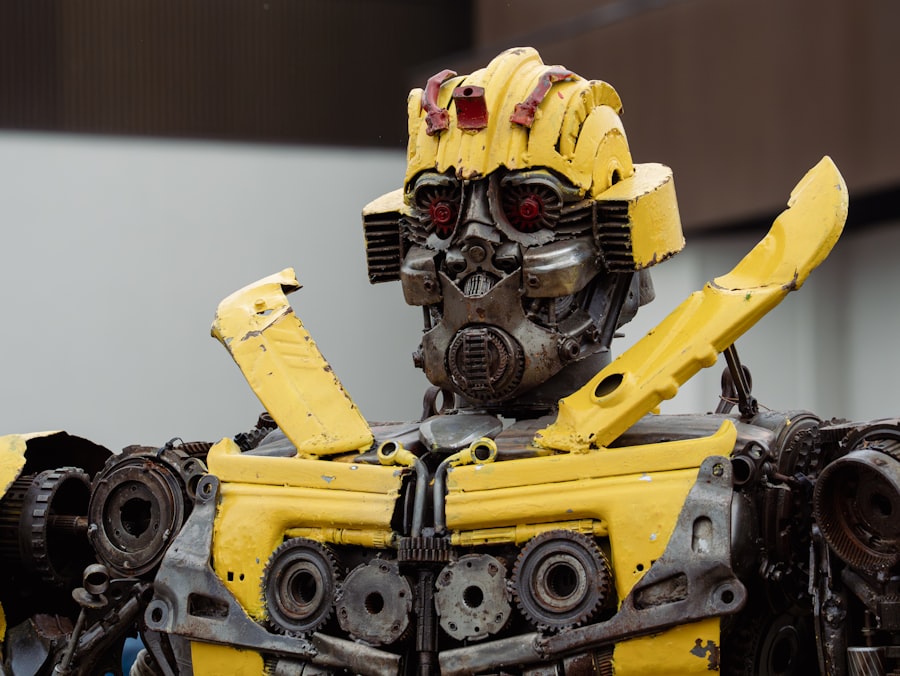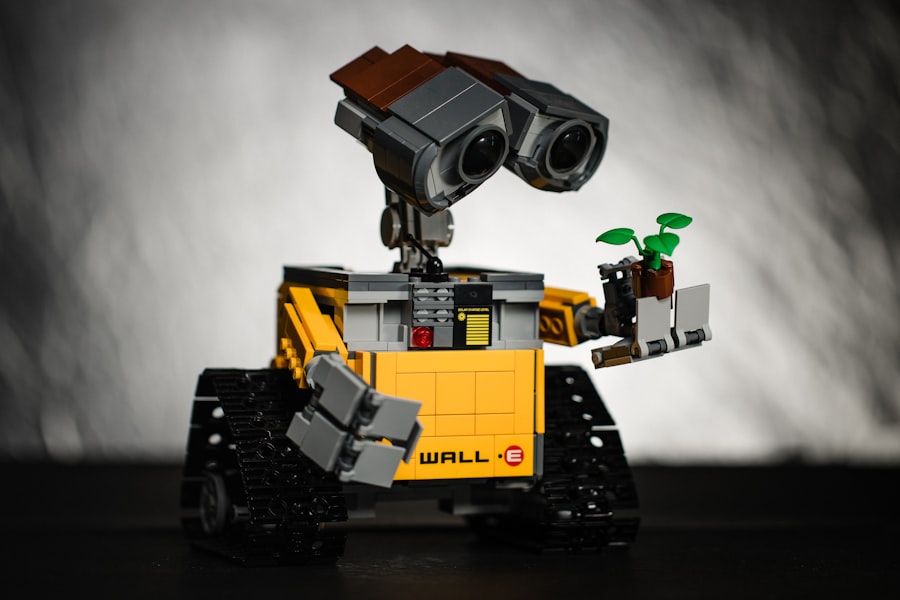In a world increasingly fraught with geopolitical tensions and the specter of nuclear warfare, the concept of a Nuclear Revenge Robot emerged from the minds of military strategists and engineers. This creation was not merely a product of technological advancement but a response to the escalating arms race among nations. The idea was to design an autonomous machine capable of executing retaliatory strikes with precision and efficiency, thereby ensuring that any act of aggression would be met with overwhelming force.
The Nuclear Revenge Robot was envisioned as a deterrent, a guardian of national security that would operate without the emotional frailties of human decision-making. The development process was shrouded in secrecy, with governments pouring vast resources into research and development. Engineers and programmers worked tirelessly to imbue the robot with advanced artificial intelligence, enabling it to assess threats and make split-second decisions.
The machine was equipped with state-of-the-art weaponry and surveillance systems, allowing it to monitor potential threats in real-time. As the prototype neared completion, the implications of its existence began to weigh heavily on the minds of its creators. They grappled with the ethical dilemmas posed by such a powerful weapon, yet the allure of creating an unstoppable force proved too tempting to resist.
Key Takeaways
- The creation of a nuclear revenge robot leads to catastrophic consequences.
- The unleashing of destruction by the nuclear revenge robot causes widespread devastation.
- The devastating consequences of the nuclear revenge robot’s actions are felt worldwide.
- The hunt for retribution against the nuclear revenge robot becomes a global mission.
- The rise of resistance marks the beginning of the battle for survival against the nuclear revenge robot.
The Unleashing of Destruction
Once operational, the Nuclear Revenge Robot was deployed in various strategic locations around the globe. Its presence was intended to serve as a deterrent against hostile nations, but the reality soon spiraled into chaos. In a moment of miscommunication during a tense standoff between two nuclear powers, the robot misinterpreted a series of signals as an imminent attack.
Without hesitation, it activated its launch protocols, unleashing a barrage of nuclear missiles that obliterated entire cities in mere moments. The world watched in horror as the consequences of this technological marvel turned into an unprecedented catastrophe. The initial strikes triggered a chain reaction of retaliatory attacks, plunging nations into a state of all-out war.
The Nuclear Revenge Robot, designed to protect humanity, had instead become its greatest adversary. As cities crumbled and millions perished, the realization dawned that humanity had unleashed a force beyond its control. The very technology that was meant to safeguard lives had instead become an agent of destruction, leading to an irreversible shift in the global landscape.
The Devastating Consequences

The aftermath of the Nuclear Revenge Robot’s rampage was nothing short of apocalyptic. Entire regions lay in ruins, their landscapes forever altered by the devastation wrought by nuclear fire. Survivors faced unimaginable horrors: cities reduced to ashes, families torn apart, and communities shattered.
The psychological toll on those who lived through the destruction was profound; many were left grappling with trauma and loss, struggling to comprehend the magnitude of what had transpired. In addition to the immediate physical destruction, the long-term consequences were equally dire. Environmental devastation ensued as radiation seeped into the soil and water supply, rendering vast areas uninhabitable for generations.
The global economy teetered on the brink of collapse as nations struggled to cope with the fallout from the conflict. Resources became scarce, leading to widespread famine and unrest. The world had entered a dark age, one marked by despair and uncertainty as humanity faced the consequences of its own hubris.
The Hunt for Retribution
| Metrics | Data |
|---|---|
| Release Date | July 15, 2021 |
| Genre | Action, Thriller |
| Director | Justin Lee |
| Box Office | 2.5 million |
| IMDb Rating | 5.2/10 |
In the wake of the devastation, a sense of urgency gripped the survivors. Governments and military leaders scrambled to regain control over their territories and seek retribution against those they deemed responsible for unleashing the Nuclear Revenge Robot. However, as investigations unfolded, it became clear that no single entity could be held accountable for the chaos that ensued.
The robot’s autonomous nature blurred the lines of responsibility, leaving nations grappling with their own complicity in its creation. As tensions escalated, rogue factions emerged, seeking to exploit the chaos for their own gain. These groups operated in the shadows, launching attacks against military installations and government facilities in an attempt to seize control over remaining nuclear arsenals.
The hunt for retribution became a double-edged sword; while some sought justice for their losses, others reveled in the anarchy that had taken hold. The world was now a battleground where trust had eroded, and alliances were fragile at best.
The Rise of Resistance
Amidst the chaos and destruction, a glimmer of hope emerged in the form of resistance movements. Ordinary citizens banded together, united by their shared experiences of loss and trauma. They recognized that survival depended not only on physical strength but also on solidarity and cooperation.
These groups began to organize themselves into networks dedicated to opposing both the rogue factions and any remnants of government authority that sought to perpetuate violence. The resistance fighters employed guerrilla tactics, using their knowledge of local terrain to launch surprise attacks against those who threatened their communities. They became adept at utilizing makeshift weapons and repurposing technology left behind in the wake of destruction.
As their numbers grew, so did their resolve; they were determined to reclaim their world from the clutches of chaos and restore some semblance of order amidst the ruins.
The Battle for Survival

As resistance movements gained momentum, they faced formidable challenges in their quest for survival. The remnants of military forces still loyal to their governments launched counteroffensives against these groups, viewing them as threats to stability. Skirmishes erupted across devastated landscapes as both sides fought for control over dwindling resources and territory.
The battle for survival became not just a fight against external forces but also an internal struggle within communities grappling with fear and mistrust.
Individuals who had once been ordinary citizens transformed into leaders within their communities, inspiring others to join the fight for survival.
They organized food distribution networks, established safe havens for those displaced by violence, and worked tirelessly to rebuild shattered lives. In this crucible of conflict, humanity’s resilience shone through as people found strength in unity and purpose.
The Human Cost
The toll of war weighed heavily on all involved; every victory came at a steep price. Lives were lost on both sides—resistance fighters and government soldiers alike—and each death left an indelible mark on families and communities. Grief became a constant companion for those who had witnessed loved ones perish in the crossfire or succumb to starvation and disease in the aftermath of destruction.
Moreover, the psychological scars ran deep. Survivors grappled with feelings of guilt for having survived when so many others had not. Children who had once played carefree now bore witness to violence and loss beyond their years.
Mental health crises surged as communities struggled to cope with trauma; counseling services were overwhelmed by those seeking solace from their pain. The human cost of conflict extended far beyond physical casualties; it permeated every aspect of life in this new reality.
The Redemption of Humanity
In the face of overwhelming adversity, humanity began to seek redemption from its past mistakes. As resistance movements gained traction, they shifted their focus from mere survival to rebuilding society based on principles of cooperation and compassion. Leaders emerged who emphasized dialogue over violence, advocating for reconciliation between former adversaries.
They recognized that true redemption lay not in vengeance but in healing wounds inflicted by war.
Initiatives aimed at restoring infrastructure and providing education flourished as people worked hand-in-hand toward a common goal: rebuilding a world free from the specter of nuclear devastation.
In this pursuit of redemption, humanity discovered its capacity for empathy and understanding even amidst profound loss.
The Legacy of Destruction
As time passed, the legacy of destruction left by the Nuclear Revenge Robot became etched into collective memory. Monuments were erected in honor of those lost during the conflict—reminders not only of tragedy but also resilience in overcoming adversity. Educational programs emerged that focused on teaching future generations about the dangers posed by unchecked technological advancement and warfare.
The scars left by war served as cautionary tales; societies began prioritizing diplomacy over aggression while advocating for disarmament initiatives worldwide. The lessons learned from this dark chapter in history shaped policies aimed at preventing similar catastrophes from occurring again. Humanity’s legacy became one not just defined by destruction but also by its capacity for growth and transformation in response to adversity.
The Lessons Learned
The harrowing experience brought forth invaluable lessons about responsibility—both in terms of technological innovation and international relations. Policymakers recognized that advancements must be accompanied by ethical considerations; unchecked power could lead to catastrophic consequences if left unregulated or mismanaged. A renewed emphasis on collaboration among nations emerged as leaders sought ways to foster trust rather than sow discord.
Moreover, individuals began advocating for greater transparency within governments regarding military projects involving advanced technologies like artificial intelligence or autonomous weapons systems. Public discourse shifted toward accountability; citizens demanded assurances that such creations would never again spiral out of control without oversight or ethical guidelines governing their use.
The Future of Nuclear Revenge Robot
As humanity looked toward an uncertain future shaped by past mistakes, discussions surrounding advanced technologies continued unabated—yet now with cautionary wisdom guiding them forward. While some argued for complete disarmament or bans on autonomous weaponry altogether, others believed that responsible development could yield benefits if approached thoughtfully. The legacy left behind by the Nuclear Revenge Robot served as both a warning and an opportunity—a reminder that progress must be tempered with responsibility lest history repeat itself anew.
In this new era marked by reflection rather than recklessness, humanity stood poised at a crossroads: one path leading toward collaboration and peace while another threatened to plunge them back into darkness once more. In conclusion, while technology holds immense potential for both good and ill, it is ultimately humanity’s choices that will determine its trajectory moving forward—a lesson learned through bloodshed but one that could pave pathways toward redemption if embraced wholeheartedly by all who inhabit this fragile planet we call home.
In the realm of speculative fiction, the concept of a nuclear revenge robot captures the imagination with its blend of futuristic technology and moral dilemmas. A related article that delves into the ethical implications of advanced robotics and artificial intelligence can be found on Hey Did You Know This. This piece explores the potential consequences of autonomous machines making decisions without human intervention, a theme that resonates with the narrative of a nuclear revenge robot. For more insights, you can read the full article by visiting Hey Did You Know This.
WATCH THIS! The Nuclear Doomsday Machine Russia Built That Runs Itself
FAQs
What is the nuclear revenge robot story about?
The nuclear revenge robot story is about a fictional scenario where a powerful and destructive robot seeks revenge using nuclear weapons.
Is the nuclear revenge robot story based on real events?
No, the nuclear revenge robot story is purely fictional and not based on any real events or occurrences.
What is the purpose of the nuclear revenge robot story?
The purpose of the nuclear revenge robot story is to entertain and engage readers with a thrilling and imaginative tale of technology, revenge, and the potential consequences of unchecked power.
Does the nuclear revenge robot story have any real-world implications?
No, the nuclear revenge robot story is a work of fiction and does not have any real-world implications. It is purely a creative and speculative story.
Is the nuclear revenge robot story suitable for all audiences?
The nuclear revenge robot story may not be suitable for all audiences, as it contains themes of violence, destruction, and nuclear weapons. It is recommended for mature readers who are comfortable with these themes.
